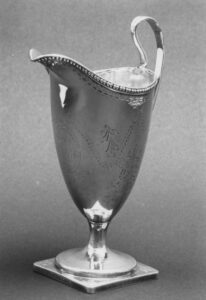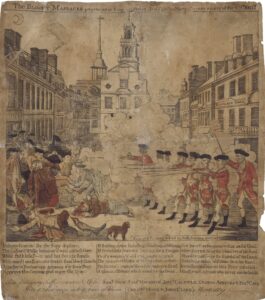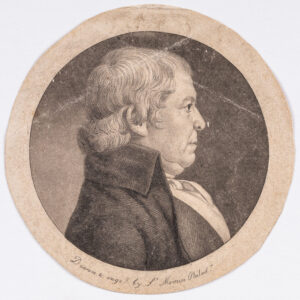
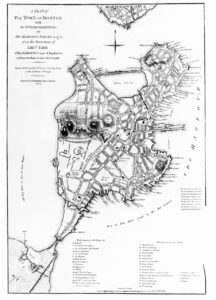 1734
1734
Paul is born in the North End of Boston.
1741
At the age of 6, Paul begins attending North Writing School on Love Lane in Boston. Learns to read and write there.
1750
15 year old Paul signs a contract with Old North Church (Christ Church) to be part of a bell-ringers group.
1754
After the death of his father, Apollos Rivoire, Paul is not yet ready to take over the family business. We believe Deborah, his mother, handled the business affairs until Paul could legally take over at the age of 21.
1757
Paul marries Sarah Orne in August. He is 23 years old.
1758
Paul’s first child, Deborah Revere, is born.
1764
When Paul is 29, a smallpox outbreak occurs in the Revere household and their house is placed under quarantine until it passes. Paul refuses to send any of his “little lambs” to the pest house.
1765
The Stamp Act is passed by Parliament in March. This measure requires the American colonists to purchase tax stamps to be placed on most forms of printed material. Passage of the Act provokes almost immediate opposition in the colonies, where it is considered to be an illegal revenue raising device.
“Sons of Liberty” patriot groups first form in July and August to oppose the Stamp Act.
Paul engraves his earliest known political cartoon, “A View of the Year 1765,” in November in opposition to the Stamp Act.
1766
Repeal of the Stamp Act on March 18th. The Declaratory Act, passed the same day, affirms Parliament’s authority over the American colonies.
1767
The Townshend Acts are passed by Parliament. These Acts establish duties in the colonies on imported glass, lead, paper, paint, and tea.
1768
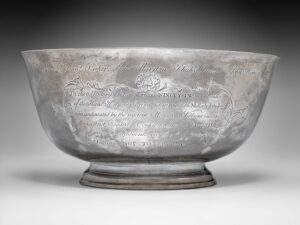 Paul makes and engraves the “Liberty Bowl” to honor 92 members of the Massachusetts House of Representatives who refused to rescind a circular letter sent to the other colonies protesting the Townshend Acts.
Paul makes and engraves the “Liberty Bowl” to honor 92 members of the Massachusetts House of Representatives who refused to rescind a circular letter sent to the other colonies protesting the Townshend Acts.
British troops arrive at Boston Harbor in October to control unrest provoked by the Townshend Acts.
1770
When Paul is 35 years old, he purchases a house on North Square in the North End of Boston. This house still stands and is operated as a museum by the Paul Revere Memorial Association.
The Boston Massacre occurs on March 5th. Harassed British soldiers fire into a large, unruly crowd, killing three and wounding several others (two would die of their injuries, bringing the total deaths to five). Paul Revere produces an engraving of the Massacre for propaganda purposes, as well as an accurate drawing, intended as evidence at the trial of the British soldiers in October.
Repeal of all of the Townshend Acts in April, except for the small tax on tea retained as a symbol of Parliament’s right to tax the colonies.
1771
Revere creates an illuminated display in the windows of his North Square home commemorating the first anniversary of the Boston Massacre.
1772
Paul joins the Long Room Club and the North End Caucus, both radical patriot groups associated with the “Sons of Liberty.”
1773
Paul’s first wife Sarah dies in May, after having 8 children. Paul remarries his second wife Rachel Walker in October. Paul is 38 years old.
The Boston Tea Party is planned at meetings of the North End Caucus and other Patriot groups in November and early December. On the evening of December 16, groups of patriots disguised as “Mohawks” march to Griffin’s Wharf and throw the contents of 340 chests of East India Company tea into Boston harbor. Revere attended most of the meetings of the North End Caucus, and was probably one of those responsible for the actual destruction of the tea.
Paul takes many rides on behalf of the Sons of Liberty, sending and receiving messages. James Otis, Sr. wrote him an introduction so that he could get the supplies he needed.
1774
Parliament passes the Coercive or “Intolerable” Acts, effectively revoking the Massachusetts Charter and closing the port of Boston.
In September Paul rides to the First Continental Congress in Philadelphia, Pennsylvania, with copies of the Suffolk Resolves. Written by the radical leader Dr. Joseph Warren, the Resolves declared the Coercive Acts unconstitutional, and advised the people to form their own militias.
In December Paul rides to Portsmouth, New Hampshire, with news of British plans to reinforce Fort William and Mary. Local patriots are able to seize the fort after token opposition.
Learn about Paul Revere’s other, lesser known rides here
1775
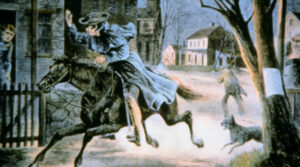 Paul Revere and William Dawes, a Boston cordwainer, ride to Lexington, Massachusetts, by separate routes to warn of the impending arrival of British troops. British troops and American militia (“minutemen”) clash at Lexington and Concord on April 18th.
Paul Revere and William Dawes, a Boston cordwainer, ride to Lexington, Massachusetts, by separate routes to warn of the impending arrival of British troops. British troops and American militia (“minutemen”) clash at Lexington and Concord on April 18th.
Unable to return to Boston due to the outbreak of hostilities after Lexington and Concord, Revere goes to Watertown, where he prints currency for the Massachusetts Provincial Congress. Paul and Rachel write letters back and forth, coordinating her escape with the children from Boston.
Read more about Paul’s letter to Rachel here
Paul rides to Philadelphia with letters for Samuel and John Adams, and returns with plans for a gunpowder mill.
The Battle of Bunker Hill takes place on June 17th. British troops defeat a larger American force, but suffer heavy casualties and are unable to break out of Boston. Paul, Rachel and the children remain in Watertown during the siege of Boston from 1775 into 1776.
1776
British troops evacuate Boston in March. Paul Revere returns and attends the funeral of his friend and fellow patriot Dr. Joseph Warren, killed at the Battle of Bunker Hill.
Revere is commissioned a Major in the Massachusetts Militia in April. By November he has been promoted to Lieutenant Colonel in the Massachusetts State Artillery. Revere spends most of the next three years as commander of Castle Island, a fort near the entrance to Boston Harbor.
1777
Paul takes part in the first Independence Day celebration in Boston. He gives orders for signals to be shown and cannon to be fired at Castle Island.
Paul participates in the first expedition against the British in Newport, Rhode Island, in September.
1778
In August Paul participates in the second expedition against the British at Newport. The Americans are forced to retreat, but fight a successful rearguard action (the “Battle of Newport”).
1779
During the summer, Revere commands the Massachusetts militia artillery on the ill-fated expedition to capture a British fort in Penobscot Bay, Maine. Following the disaster, Revere is accused of cowardice and insubordination, and is dismissed from the militia. He returns to his silversmith shop in Boston.
1781
British general Lord Cornwallis surrenders to the Americans and the French at Yorktown, Virginia.
1782
Revere’s seventh request for a court-martial is granted. He is formally acquitted of the charges arising out of the Penobscot expedition.
1783
The Treaty of Paris is signed. Great Britain formally acknowledges the independence of the American states.
1785
Revere takes part in artisan agitation in favor of tariffs on imported manufactured goods.
1787
Paul’s youngest child is born. He is named John and is Paul’s sixteenth child.
1788
Revere is one of the leaders of a meeting of tradesmen and artisans which drafts resolutions favoring the adoption of the proposed United States Constitution. The resolutions are carried in procession to the Massachusetts ratifying convention, where they are presented to Samuel Adams, the presiding officer.
1792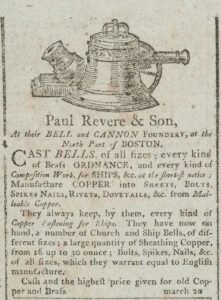
At the age of 57 Paul branches out and starts manufacturing church bells at his foundry in Boston. Some of his bells are still being used today.
1799
Paul Revere becomes president of the Boston Board of Health.
1800
Paul sells his house on North Square and moves into a house on Charter St., still in Boston’s North End neighborhood. He is 65 years old.
1801
Paul Revere’s daughter Maria leaves to attend boarding school in Woburn, MA. This is one example of how Paul’s younger children had better opportunities than his older children due to his greater financial stability later in life.
1813
Paul’s second wife, Rachel, dies. She is 68 years old.
1814
Paul Revere sends his employees to work on Boston harbor fortifications in anticipation of British ships arriving during the War of 1812.
1818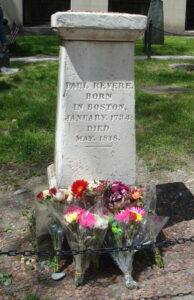
Paul Revere dies at age 83 and is buried in the Granary Burying Ground in Boston.
1860
Henry Wadsworth Longfellow begins writing his poem, “Paul Revere’s Ride,” in April 1860. The poem is first published locally in the Boston Evening Transcript on December 18th, and then nationally in the January 1861 issue of the Atlantic Monthly. This poem helped transform Revere from a minor Revolutionary War figure into a national hero.
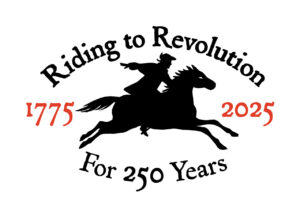
Funded in part by Julia and Mark Casady and the One Step Forward Education Foundation
Special thanks to the National Parks of Boston and Matt Conti
Design and Development by Cardinal Digital Design and Adrienne Turnbull-Reilly
Copyright © 2025 the Paul Revere Memorial Association

